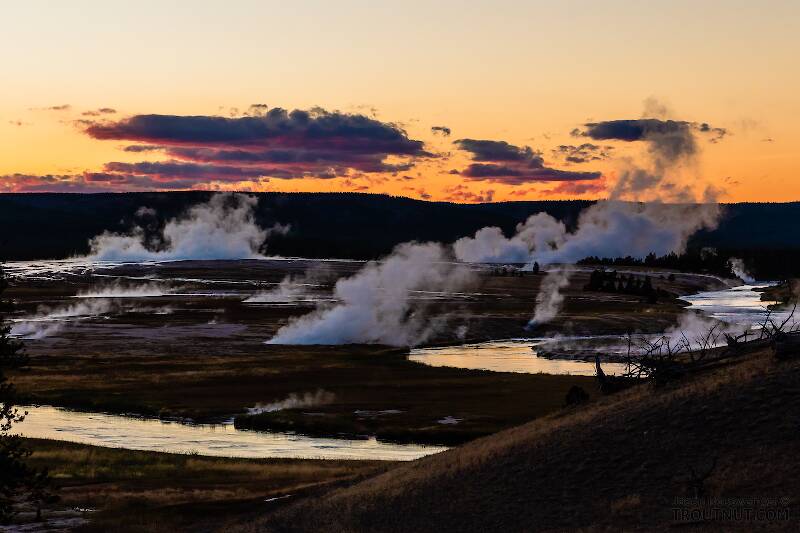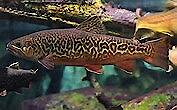
Salmonflies
Pteronarcys californica
The giant Salmonflies of the Western mountains are legendary for their proclivity to elicit consistent dry-fly action and ferocious strikes.
Featured on the forum

This specimen keys pretty easily to Onocosmoecus, and it closely resembles a specimen from Alaska which caddis expert Dave Ruiter recognized as this genus. As with that specimen, the only species in the genus documented in this area is Onocosmoecus unicolor, but Dave suggested for that specimen that there might be multiple not-yet-distinguished species under the unicolor umbrella and it would be best to stick with the genus-level ID. I'm doing the same for this one.

Troutnut is a project started in 2003 by salmonid ecologist Jason "Troutnut" Neuswanger to help anglers and
fly tyers unabashedly embrace the entomological side of the sport. Learn more about Troutnut or
support the project for an enhanced experience here.
Flytyerinpa on Aug 5, 2016August 5th, 2016, 11:02 am EDT
I've just started adding weight to my fly's and started to wonder is there a set amount, for a set size hook anybody ever remember reading where the standard #12 wet fly should be wrapped with 8-10 or 12 wraps of lead or lead substitute ???
RleeP on Aug 5, 2016August 5th, 2016, 11:30 am EDT
It largely depends upon your intended use for the fly you are tying and I don't really think there is an acknowledged standard for the number of wraps you should make. If you are tying a wet fly to imitate an insect that is just leaving the bottom of the stream or if you are fishing in faster deeper flows and need to get the fly down, you might use more weight. In other situations where you want the fly to ride higher in the water column, you might use less.
Of course, if you tried to weight every fly you tie to specifically fit every potential situation you meet on the water, you'd have to have two angling assistants to help you carry all your flies and a tech guy to maintain your 40,000 option database of what is available.
This is one of the reasons God gave us split shot...
Anyway, you could do something like this:
Let's say you like fishing a Leadwing Coachman wet in size #12. It is a good fly.. Using .015 wire, you could make some with 4 turns of weight and some with 8 and maybe even some with no weight. When you tie them, use different colors of thread for the head so you can tell which is which.
That's a nice manageable system that works.
Of course, if you tried to weight every fly you tie to specifically fit every potential situation you meet on the water, you'd have to have two angling assistants to help you carry all your flies and a tech guy to maintain your 40,000 option database of what is available.
This is one of the reasons God gave us split shot...
Anyway, you could do something like this:
Let's say you like fishing a Leadwing Coachman wet in size #12. It is a good fly.. Using .015 wire, you could make some with 4 turns of weight and some with 8 and maybe even some with no weight. When you tie them, use different colors of thread for the head so you can tell which is which.
That's a nice manageable system that works.
Silvercreek
Posts: 2
Posts: 2
Silvercreek on Aug 10, 2016August 10th, 2016, 4:21 am EDT
I use mostly unweighted nymphs. Even if you weight the nymph you need multiple weights as noted above. That means you need to carry and tie more flies. It also means you need to clip off the old fly and tie on a fly of a different weight
Secondly weighted flies do not drift naturally. Real nymphs are neutrally buoyant since they are mostly water. Weighted nymphs drift like weight ---> DEAD weight. Weighted nymphs will work in very fast erratic flow conditions where a fish has little time top decide whether to take a fly or not, but they are not as effective in slower flows. Unweighted nymphs are effective everywhere.
Split shot and micro shot allow you to separate the weight from the drifting fly and they allow a much simpler system of weight management.
Take a look at this video below of a free drifting stonefly nymph at 1 minute 10 seconds into the video. Would a bead head or a heavily weight nymph drift in like the real nymph in the video below?
http://www.youtube.com/watch?v=E4Al8cwkb4I
I discuss this in more detail in these two posts:
http://www.theflyfishingforum.com/forums/coldwater-fly-fishing/358618-adding-weight-nymphs-strike-indicators.html#post700580
http://www.theflyfishingforum.com/forums/coldwater-fly-fishing/358618-adding-weight-nymphs-strike-indicators.html#post700595
Secondly weighted flies do not drift naturally. Real nymphs are neutrally buoyant since they are mostly water. Weighted nymphs drift like weight ---> DEAD weight. Weighted nymphs will work in very fast erratic flow conditions where a fish has little time top decide whether to take a fly or not, but they are not as effective in slower flows. Unweighted nymphs are effective everywhere.
Split shot and micro shot allow you to separate the weight from the drifting fly and they allow a much simpler system of weight management.
Take a look at this video below of a free drifting stonefly nymph at 1 minute 10 seconds into the video. Would a bead head or a heavily weight nymph drift in like the real nymph in the video below?
http://www.youtube.com/watch?v=E4Al8cwkb4I
I discuss this in more detail in these two posts:
http://www.theflyfishingforum.com/forums/coldwater-fly-fishing/358618-adding-weight-nymphs-strike-indicators.html#post700580
http://www.theflyfishingforum.com/forums/coldwater-fly-fishing/358618-adding-weight-nymphs-strike-indicators.html#post700595
PaulRoberts on Aug 11, 2016August 11th, 2016, 10:20 am EDT
True that real nymphs drift "naturally". But they are not tethered to a line. Weight -along with the entire rig and how its fished- can actually help a tethered fly drift more naturally, and provide strike detection too. Real live nymphs so tethered can also drift unnaturally, and the fish often respond equally negatively. It's the tether not necessarily the fly or weight that is the main issue.
For shallow and slow water I use weightless or lightly weighted flies, and add shot, twist-on, or putty. For fast and/or deep, I use heavy lead and/or lead eyes and/or tungsten beads. Realize as shank weight increases hook may roll over upside down so plan accordingly.
Lastly, amount of weight has much to do with the line weight rod you're using. A 4wt is fine for generally light nymphing. I go up to a 5 or 6 for heavier stuff.
Apologies for the indirect answer. It's been trial and error for me. I haven't quantified, although this is easier with beads since they are already of set weights. Then there is tippet diameter, technique, fly buoyancy/adhesion, water density/viscosity, and the vagaries of current -all that fishing stuff.
Hope this helps in some way.
For shallow and slow water I use weightless or lightly weighted flies, and add shot, twist-on, or putty. For fast and/or deep, I use heavy lead and/or lead eyes and/or tungsten beads. Realize as shank weight increases hook may roll over upside down so plan accordingly.
Lastly, amount of weight has much to do with the line weight rod you're using. A 4wt is fine for generally light nymphing. I go up to a 5 or 6 for heavier stuff.
Apologies for the indirect answer. It's been trial and error for me. I haven't quantified, although this is easier with beads since they are already of set weights. Then there is tippet diameter, technique, fly buoyancy/adhesion, water density/viscosity, and the vagaries of current -all that fishing stuff.
Hope this helps in some way.
Flytyerinpa on Aug 12, 2016August 12th, 2016, 9:43 am EDT
First of all I want to thank every body that replied so far I've saw and learned about things I never thought about. And that YouTube clip just blew me away, who ever made it really put some time into it. I guess the only down fall is I wish I would have gotten into fly fishing when I was like 5 yrs. instead of 50 + years later, hopefully there are trout streams up there in the after life and we can have the opportunity to continue learning about our great sport. Once again thanks to all that replied the info was priceless.
RleeP on Aug 12, 2016August 12th, 2016, 10:42 am EDT
Welcome to the world of fly fishing. I see you're around Pottsville. If you want to hook up with a good bunch of folks who are always asking each other questions like: "How many wraps of lead should I put on a fly?" and other matters of great import, you might consider looking into joining the Pottsville-based Schuylkill County Chapter of Trout Unlimited. They've long been a very positive force for improving and caretaking local trout waters. There, you'll find fishing buddies, fly tying and fishing advice and also become a part of a better future for wild trout in Pennsylvania.
Here's the web site: http://schuylkillcountytu.org/
Here's the web site: http://schuylkillcountytu.org/
Quick Reply
Related Discussions
Topic
Replies
Last Reply
2
Oct 4, 2006
by GONZO
by GONZO
0
Jul 2, 2012
by Bjorntofish
by Bjorntofish
2
May 17, 2018
by Subway
by Subway



